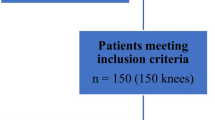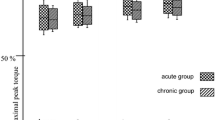Abstract
In athletes, anterior cruciate ligament (ACL) reconstruction is recommended after injury to restore the normal knee function and allow subsequent return to sport. Successful ACL reconstruction with patellar tendon (PT) and hamstring tendon (HT) grafts combined with a well-structured rehabilitation program could bring athletes back to their previous level of sport activities. We prospectively followed-up 100 athletes who underwent ACL reconstruction with either PT (n=50) or HT grafts (n=50). Evaluation was done pre-operatively and post-operatively (3, 6, 12, and 24 months) using International Knee Documentation Committee (IKDC), Lysholm, Noyes, and Tegner scales. Subjective assessment numeric evaluation (SANE), knee activity rating scale (Marx) and a psychological profile questionnaire (psychovitality) were also utilized. Objective evaluations included isokinetic tests and computerized knee motion analysis. Data gathered were statistically analyzed using the Mann–Whitney non-parametric U-test. Among the 100 patients who have undergone ACL reconstruction, 65% returned to the same level of sports, 24% changed sports and 11% ceased sport activities. No significant difference (P>0.05) in outcome between PT and HT grafts were observed. No significant differences (P>0.05) were noted between athletes who “returned” to their previous sport and those who “did not return” to sports at the same level when using the IKDC, Lysholm, Noyes, and Tegner knee evaluation scales. However, significant difference was observed with the knee scores obtained by those who returned and those who completely ceased participation in sport activities. Computerized laxity test revealed that 90% of these patients have less than 3 mm side-to-side difference with no significant difference between HT and PT groups. Patients who “returned to sports” obtained significantly better scores with the Marx scale (P=0.001) and the psychovitality questionnaire (P=0.001) than those who did not. Conventional knee scales including IKDC, Lysholm, Noyes, and Tegner remain as reliable means of evaluating outcome of ACL reconstruction. However, the data obtained from these are not sufficient to determine which among the patients who had knee reconstruction can successfully return to sport. The use of the Marx knee activity rating scale and the evaluation of the athletes’ psychological profile are additional scales that can be useful in determining which among the patients treated have a better chance of returning to their pre-injury activity levels.





Similar content being viewed by others
References
Adachi N, Ochi M, Uchio Y et al (2002) Mechanoreceptors in the anterior cruciate ligament contribute to the joint position sense. Acta Orthop Scand 73:330–334
Aglietti P, Buzzi R, Zaccherotti G et al (1997) A comparison between patellar tendon versus doubled semitendinosus/gracilis tendon for anterior cruciate ligament reconstruction. A minimum five-year follow-up. J Sports Traumatol Rel Res 19:57–68
Beynnon BD, Johnson RJ, Fleming BC (2002) The science of anterior cruciate ligament rehabilitation. Clin Orthop 402:9–20
Daniel D, Stone M, Dobson B et al (1994) Fate of the ACL-injured patient. A prospective outcome study. Am J Sports Med 22(5):632–644
Dye S, Wojtys E, Fu F et al (1998) Factors contributing to function of the knee joint after injury of reconstruction of the anterior cruciate ligament. J Bone Joint Surg 80A:1380–1393
Frank CB, Jackson DW (1997) The science of reconstruction of the anterior cruciate ligament. J Bone Joint Surg 79A:1556–1576
Friden T, Roberts D, Ageberg E et al (2001) Review of knee proprioception and the relation to extremity function after an anterior cruciate ligament rupture. J Orthop Sports Phys Ther 31:567–576
Georgoulis AD, Pappa L, Moebius U et al (2001) The presence of proprioceptive mechanoreceptors in the remnants of the ruptured ACL as a possible source of re-innervation of the ACL autograft. Knee Surg Sports Traumatol Arthrosc 9:364–368
Gobbi A, Tuy B, Mahajan S et al (2003) Quadrupled bone-semitendinosus anterior cruciate ligament reconstruction: a clinical investigation in a group of athletes. Arthroscopy 19(7):691–699
Gobbi A, Tuy B, Mahajan S et al (2003) Patellar tendon versus quadrupled bone-semitendinosus anterior cruciate ligament reconstruction: a prospective clinical investigation in athletes. Arthroscopy 19(6):592–601
Goh S, Boyle J (1997) Self-evaluation and functional testing two to four years post ACL reconstruction. Aust J Physiother 43:255–262
Hefti F, Muller W, Jakob R et al (1993) Evaluation of knee ligament injuries with the IKDC form. Knee Surg Sports Traumatol Arthrosc 1:226–234
Jarvinen M, Natri A, Lehto M et al (1995) Reconstruction of chronic anterior cruciate ligament insufficiency in athletes using a bone-patellar tendon-bone autograft. Int Orthop 19:1–6
Jerre R, Ejerhed L, Wallmon A et al (2001) Functional outcome of anterior cruciate ligament reconstruction in recreational and competitive athletes. Scand J Med Sci Sports 11(6):342–346
Lephart SM, Pincivero DM, Giraldo JL et al (1997) Current concepts: the role of proprioception in the management and rehabilitation of athletic injuries. J Bone Joint Surg 25B:130–137
Lysholm J, Gilquist J (1982) Evaluation of knee ligament surgery results with special emphasis on use of a scoring scale. Am J Sports Med 10:150–154
Lysholm J, Tegner Y, Gilquist J (1984) Functional importance of different clinical findings in the unstable knee. Acta Orthop Scand 55:472
Macdonald PB, Hedden D, Pacin O et al (1996) Proprioception in anterior cruciate ligament-deficient and reconstructed knees. Am J Sports Med 24:774–778
Marx R, Stump T, Jones E et al (2001) Development and evaluation of an activity rating scale for disorders of the knee. Am J Sports Med 29(2):213–218
Morrey MA, Stuart MJ, Smith AM et al (1999) A longitudinal examination of athletes’ emotional and cognitive responses to anterior cruciate ligament injury. Clin J Sport Med 9:63–69
Nakayama Y, Shirai Y, Narita T et al (2000) Knee functions and a return to sports activity in competitive athletes following anterior cruciate ligament reconstruction. J Nippon Med Sch 67:172–176
Neuschwander D, Drez D Jr, Heck S (1996) Pain dysfunction syndrome of the knee. Orthopaedics 19(1):27–32
Noyes FR, Matthews DS, Mooar PA et al (1983) The symptomatic anterior cruciate deficient knee. Part II: The results of rehabilitation, activity modification and counseling on functional disability. J Bone Joint Surg 65A:163–174
Noyes FR, Barber SD, Mooar LA (1989) A rationale for assessing sports activity levels and limitations in knee disorders. Clin Orthop 246:238–249
Ochi M, Iwasa J, Uchio Y et al (2002) Induction of somatosensory evoked potentials by mechanical stimulation in reconstructed anterior cruciate ligaments. J Bone Joint Surg 84B:761–766
Pantano KJ, Irrgang JJ, Burdett R et al (2001) A pilot study on the relationship between physical impairment and activity restriction in persons with anterior cruciate ligament reconstruction at long-term follow-up. Knee Surg Sports Traumatol Arthrosc 9:369–378
Risberg MA, Mork M, Jenssen HK et al (2001) Design and implementation of a neuromuscular training program following anterior cruciate ligament reconstruction. J Orthop Sports Phys Ther 31:620–631
Senert N, Kartus J, Kohler K et al (1999) Analysis of subjective, objective and functional examination tests after anterior cruciate ligament reconstruction. A follow-up of 527 patients. Knee Surg Sports Traumatol Arthrosc 7:160–165
Sgaglione N, Del Pizzo W, Fox J et al (1995) Critical analysis of knee ligament rating systems. Am J Sports Med 23:660–667
Solomonow M, Baratta R, Zhou BH et al (1987) The synergistic action of the anterior cruciate ligament and thigh muscles in maintaining joint stability. Am J Sports Med 15:207–213
Tegner Y, Lysholm J (1985) Rating systems in the evaluation of knee ligament injuries. Clin Orthop 1958:43–49
Wojtys WM, Huston LJ (1994) Neuromuscular performance in normal and anterior cruciate ligament-deficient lower extremities. Am J Sports Med 22:89–104
Wojtys WM, Huston LJ (2000) Longitudinal effects of anterior cruciate ligament injury and patellar tendon autograft reconstruction on neuromuscular performance. Am J Sports Med 28:336–344
Author information
Authors and Affiliations
Corresponding author
Rights and permissions
About this article
Cite this article
Gobbi, A., Francisco, R. Factors affecting return to sports after anterior cruciate ligament reconstruction with patellar tendon and hamstring graft: a prospective clinical investigation. Knee Surg Sports Traumatol Arthrosc 14, 1021–1028 (2006). https://doi.org/10.1007/s00167-006-0050-9
Received:
Accepted:
Published:
Issue Date:
DOI: https://doi.org/10.1007/s00167-006-0050-9




